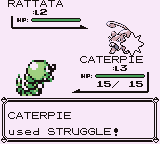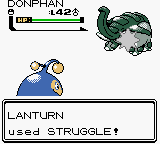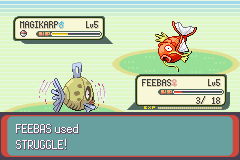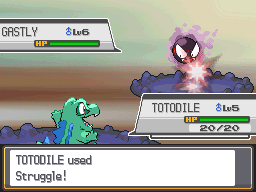Struggle (move)
| Struggle わるあがき Vain Struggle | ||||||||||||
| ||||||||||||
Target
| ||||||||||||
Availability
| ||||||||||||
| ||||||||||||
| ||||||||||||
| ||||||||||||
Struggle (Japanese: わるあがき Vain Struggle) is a move that cannot be learned naturally by any Pokémon. However, every Pokémon can use it, but only if all of their moves cannot be used, usually due to a lack of PP.
Effect
Generation I
Struggle deals damage to the opponent and the user receives recoil damage. The user takes recoil damage equal to ½ of the damage the attack did to the opponent. Struggle will automatically be used by a Pokémon that has no usable moves but is ordered to attack, and is not affected by any PP limitations. Struggle is capable of striking a critical hit.
If the user of Struggle attacks first and knocks itself out due to recoil damage, the opponent will not attack or be subjected to recurrent damage during that round. If Struggle breaks a substitute, the user will take no recoil damage.
Struggle has 10 base PP, though no PP would ever be deducted from it. Self-inflicted recoil damage from Struggle from the previous turn can be countered if the opponent did not make a move on the following turn.
Struggle deals Normal-type damage in this Generation, meaning Rock-type Pokémon take half damage, and Ghost-type Pokémon are unaffected. If the only usable move is disabled by Disable, the affected Pokémon will use Struggle.
In Stadium, no recoil damage is taken if Struggle knocks out an opponent.
Generation II
Struggle now has a maximum of 1 PP instead of 10 (16 with PP Ups). Struggle is now unaffected by type effectiveness, so inflicts normal damage to Steel-, Rock-, and Ghost-type Pokémon and is not affected by STAB. It still displays as Normal-type if hacked onto a Pokémon's moveset.
Generation III
A Pokémon will still take recoil damage even if it has an Ability that would prevent it, such as Rock Head or Wonder Guard.
Struggle can now be forced by Taunt, Torment or Imprison. If it was disabled by Torment, Struggle will be used every second turn.
If a Pokémon is holding a Choice Band and is affected by Disable, Taunt, Imprison or Cursed Body such that it cannot use the move that the Choice Band forces it to, it will always use Struggle as long as the item and the effect both remain active. If a Pokémon is holding a Choice Band and is affected by Torment, the Pokémon will use Struggle every second turn.
Generation IV and on
The user now takes ¼ of its maximum HP as recoil damage.
All effects that apply with the Choice Band now also apply with all Choice items.
Struggle is now unaffected by modifications to the accuracy stat and evasion stat.
Description
|
Learnset
All Pokémon can use Struggle when the PP for all moves they know are at 0 or the moves are somehow incapacitated such as through Disable, Taunt, Torment, Imprison, or Choice items.
In other generations
Trivia
- Even though Struggle can only be accessed by the loss of all PP, it was given Contest and Super Contest stats. This is most likely to prevent the game from crashing if a Pokémon is hacked to have Struggle as one of their four moves. The Contest stats seem to be the defaults.
- Struggle is the last non-glitch move in index number order in Generation I, and the last Generation I move in index number lists since then.
- Struggle is one of two moves that cannot be Sketched. The other is Chatter.
- In Generation I, Struggle was the only move that couldn't be used via Metronome, besides Metronome itself.
- Struggle has the lowest base power of all recoil-causing moves.
- Because it deals typeless damage, Struggle is the only damaging Normal-type move which can hit a Ghost-type opponent without the aid of Odor Sleuth, Foresight, or Scrappy.
- Along with Barrage, Kinesis, and Leech Life, Struggle is one of four moves originating from Generation I that has not been featured in the anime.
- Certain glitch Pokémon, including Generation IV hybrids, 'Ng'Mp, 'ゥ., and 4, ゥァ (DD), can learn Struggle by level up.
- Should a player hack Struggle onto a Pokémon, it won't be displayed correctly in Pokémon Stadium 2's lab (not the case for original Pokémon Stadium) and will be highlighted, as if it was a Generation II move. This doesn't happen when selecting a team for battle.
- In Pokémon Stadium and Pokémon Stadium 2, the move description erroneously states that Struggle inflicts recoil to the user equal to ¼ of the damage inflicted; prior to Generation IV, Struggle inflicts recoil damage to the user equal to ½ of the damage inflicted.
In other languages
| ||||||||||||||||||||||||||||||||||||

|
This article is part of Project Moves and Abilities, a Bulbapedia project that aims to write comprehensive articles on two related aspects of the Pokémon games. |



